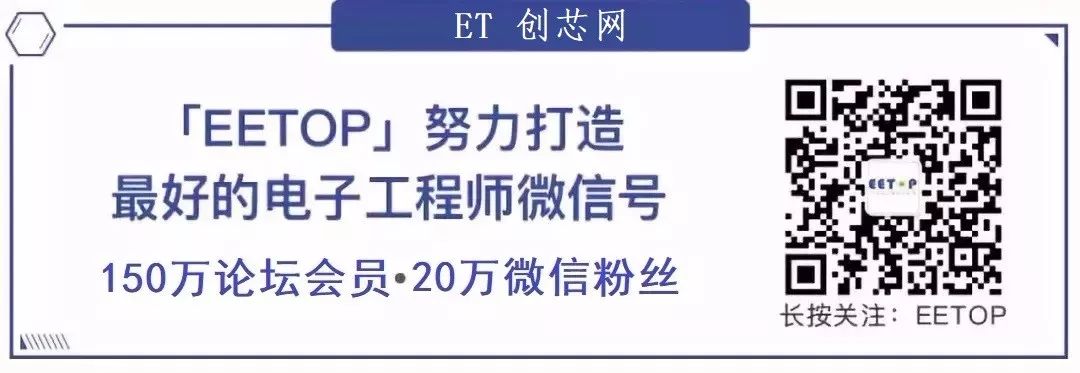
Recently, keywords like LPWAN have sparked a craze in the IoT field. With LPWAN, LoRa, and LoRaWAN having similar names, many people are confused about these three concepts.
So today, let’s explore the differences and connections between them.
LPWAN, also known as LPN, stands for Low Power Wide Area Network or Low Power Network, referring to a type of low-power wide-area network.
In summary, LPWAN has the following characteristics:
✦ Two-way communication with acknowledgment
✦ Star topology (generally does not use repeaters or mesh networking for simplicity)
✦ Low data rate
✦ Low cost
✦ Very long battery life
✦ Long communication distance
Applications suitable for LPWAN:
✦ IoT, M2M
✦ Industrial automation
✦ Low-power applications
✦ Battery-powered sensors
✦ Smart cities, smart agriculture, meter reading, streetlight control, etc.
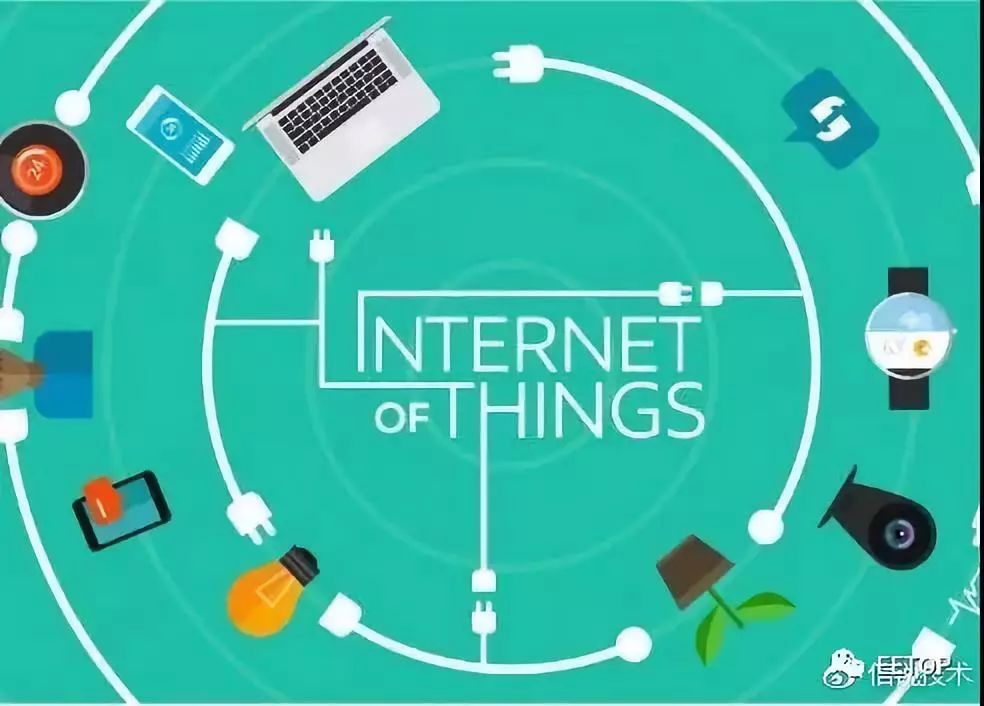
The relationship between LPWAN, LoRaWAN, and LoRa
To understand simply, the three have an inclusion relationship. The main technical representatives of LPWAN include technologies like LoRa, NB-IOT, Sigfox, etc.
Among them, LoRa is a low-power long-range wireless communication technology, mainly aimed at IoT or M2M applications, and is an important wireless technology for low-power wide-area networks (LPWAN).
LoRa technology includes the LoRaWAN protocol and the LoRa protocol. In fact, LoRaWAN refers to the MAC layer networking protocol, while LoRa is just a physical layer protocol.
Next, let’s specifically discuss the differences between LoRa and LoRaWAN:
The relationship between LoRaWAN and LoRa
Due to their similar names, many people confuse LoRaWAN with LoRa. In fact, LoRaWAN refers to the MAC layer networking protocol, while LoRa is just a physical layer protocol. Although existing LoRaWAN networks generally use LoRa as the physical layer, the LoRaWAN protocol also states that GFSK can be used as the physical layer in certain frequency bands. From a network layering perspective, LoRaWAN can use any physical layer protocol, and LoRa can serve as the physical layer for other networking technologies. In fact, several competing technologies with LoRaWAN also use LoRa at the physical layer. LoRa is a communication technology in LPWAN, promoted by the American company Semtech, which uses a spread spectrum technique for ultra-long-range wireless transmission. This approach changes the traditional trade-off considerations regarding transmission distance and power consumption, providing users with a simple system capable of achieving long distances, long battery life, and high capacity, thereby expanding sensor networks. Currently, LoRa mainly operates in global unlicensed frequency bands, including 433/868/915MHz, etc. The LoRa network mainly consists of four parts: terminals (which can have built-in LoRa modules), gateways (or base stations), servers, and the cloud. Application data can be transmitted bidirectionally. The capabilities to build LoRa networks, including LoRa modules, gateways, and cloud platforms, have matured.
What is LoRaWAN?
LoRaWAN is an open standard that defines the communication protocol for LPWAN technology based on LoRa chips. LoRaWAN defines media access control (MAC) at the data link layer and is maintained by the LoRa Alliance. The distinction between LoRa and LoRaWAN is significant because companies like Link Labs use proprietary MAC layers on top of LoRa chips to create better hybrid designs – in the case of Link Labs, called Symphony Link. At its most basic level, wireless protocols like LoRaWAN are quite simple. LoRaWAN is a star or star-to-star topology, which is generally considered better than mesh networks for maintaining battery life and increasing communication range.
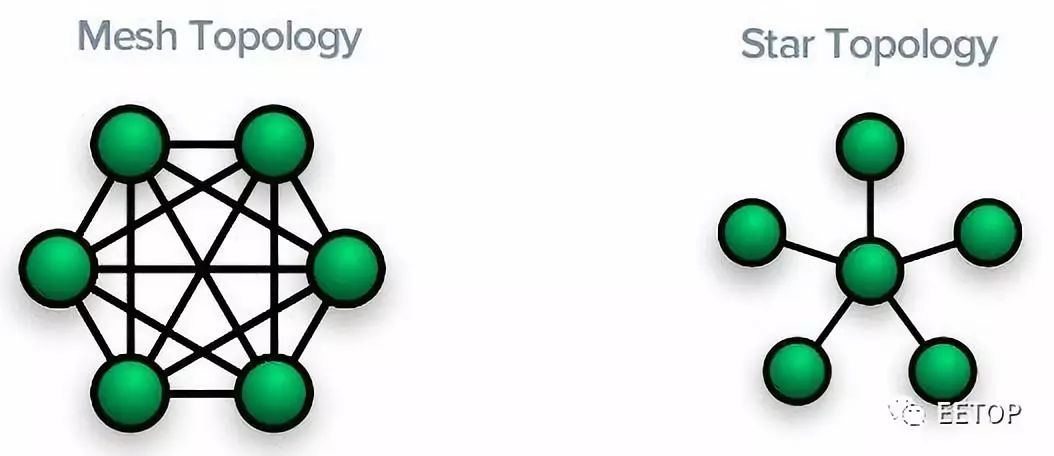
Specifically, the star topology relays messages to a central server through gateways, with each end node transmitting data to multiple gateways. The gateways then forward the data to the network server, which performs redundancy checks, security checks, and message scheduling.
This design has two obvious advantages:
1. Simpler tracking: Since end nodes send data to multiple gateways, gateway-to-gateway communication is not required. This simplifies the logic for tracking mobile applications of end nodes.
2. Better public networks: This unpaired relationship allows the central server to resolve collision issues, making LoRaWAN potentially more suitable for deployment in public networks.
How does LoRaWAN work?
At its most basic level, wireless protocols like LoRaWAN are quite simple.
LoRaWAN is a star or star-to-star topology, which is generally considered better than mesh networks for maintaining battery life and increasing communication range.
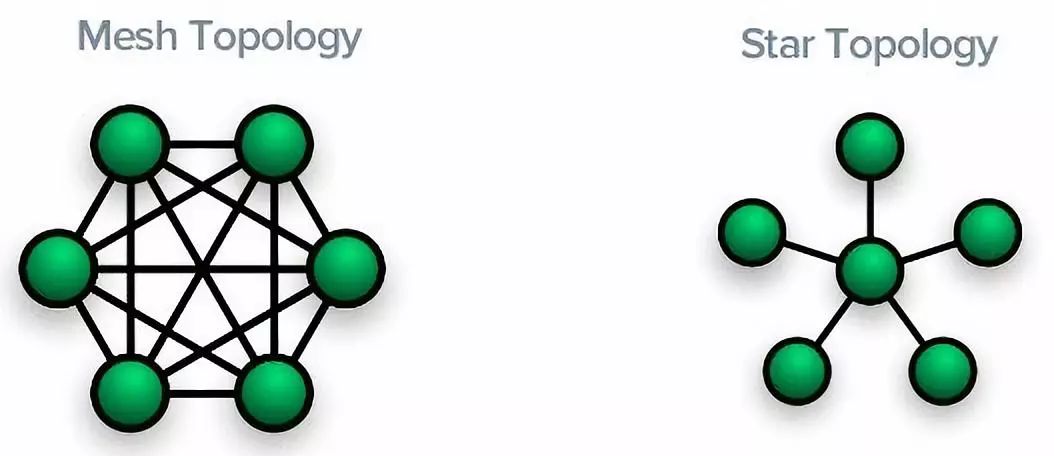
Specifically, the star topology relays messages to a central server through gateways, with each end node transmitting data to multiple gateways.
The gateways then forward the data to the network server, which performs redundancy checks, security checks, and message scheduling.
This design has two obvious advantages:
1. Simpler tracking: Since end nodes send data to multiple gateways, gateway-to-gateway communication is not required. This simplifies the logic for tracking mobile applications of end nodes.
2. Better public networks: This unpaired relationship allows the central server to resolve collision issues, making LoRaWAN potentially more suitable for deployment in public networks.
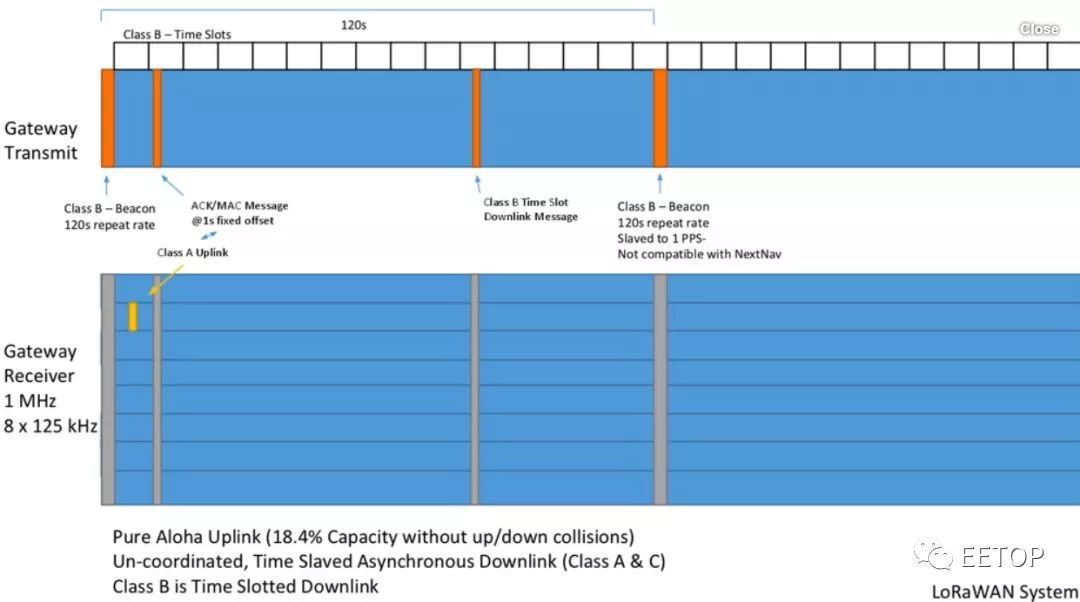
The above image shows the main operation process of LoRaWAN.
The top bar indicates whether the gateway is transmitting. (Orange indicates transmitting; blue indicates not transmitting.)
The bottom shows the receiver channels; almost all LPWAN systems (including LoRaWAN) have multiple receiving channels, and most LoRaWAN systems can receive eight messages simultaneously on any number of frequency channels.
LoRaWAN Classes A, B, and C
LoRaWAN has three classes that operate simultaneously.
Class A is asynchronous, meaning that end nodes do not wait for a specific time to communicate with the gateway but only transmit when necessary, remaining in sleep mode beforehand.
As soon as one node completes transmission, another node immediately begins.
There is no gap in communication, and the theoretical maximum capacity of a pure Aloha network is about 18.4% of this maximum value.
This is primarily due to collisions, as if one node is transmitting and another wakes up and decides to transmit using the same radio settings on the same channel, they will collide.
Class B allows messages to be sent to battery-powered nodes.
Every 128 seconds, the gateway sends a beacon. All LoRaWAN base stations send beacon messages simultaneously, as they belong to a pulse per second (1PPS).
This means that every GPS satellite in orbit transmits a message at the start of each second, synchronizing time around the world.
All Class B nodes are assigned a time slot within the 128-second cycle and are informed when to listen.
Class C allows nodes to continuously listen and can send downlink messages at any time.
This is mainly used for applications requiring communication power, as it requires significant energy to keep nodes always awake to run the receiver.
Conclusion
In summary, when faced with terms like LoRa and LoRaWAN that are easily confused, it is actually possible to see the differences once the system is sorted out.
The following table summarizes the three main characteristics of the two by a manufacturer of LoRa wireless IoT gateway devices:
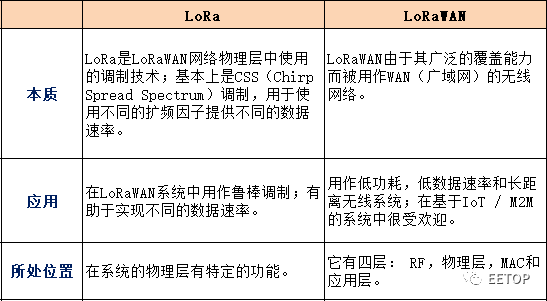
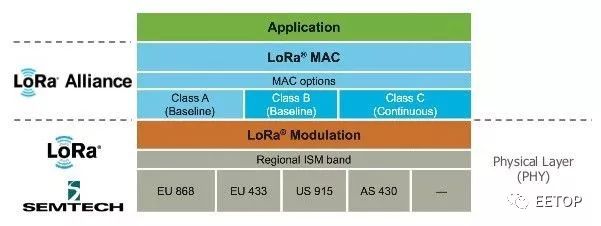
Using the above image, you can understand it with the simplest formula:
LoRa = PHY Layer
LoRaWAN or Symphony Link = MAC Layer
LoRa + LoRaWAN = LPWAN
Conference Recommendation
The “2018 National IoT Technology and Application Conference” hosted by the China Communications Society and the China Electronics Society is scheduled for November 29-December 1, 2018 at Zhijiang Hotel, Hangzhou, Zhejiang. The IoT Expert Committee of the China Electronics Society and Beijing EETOP Technology Co., Ltd. will jointly host a sub-forum at the conference on the morning of December 1, 2018: LPWAN and Edge Technology Summit Forum.
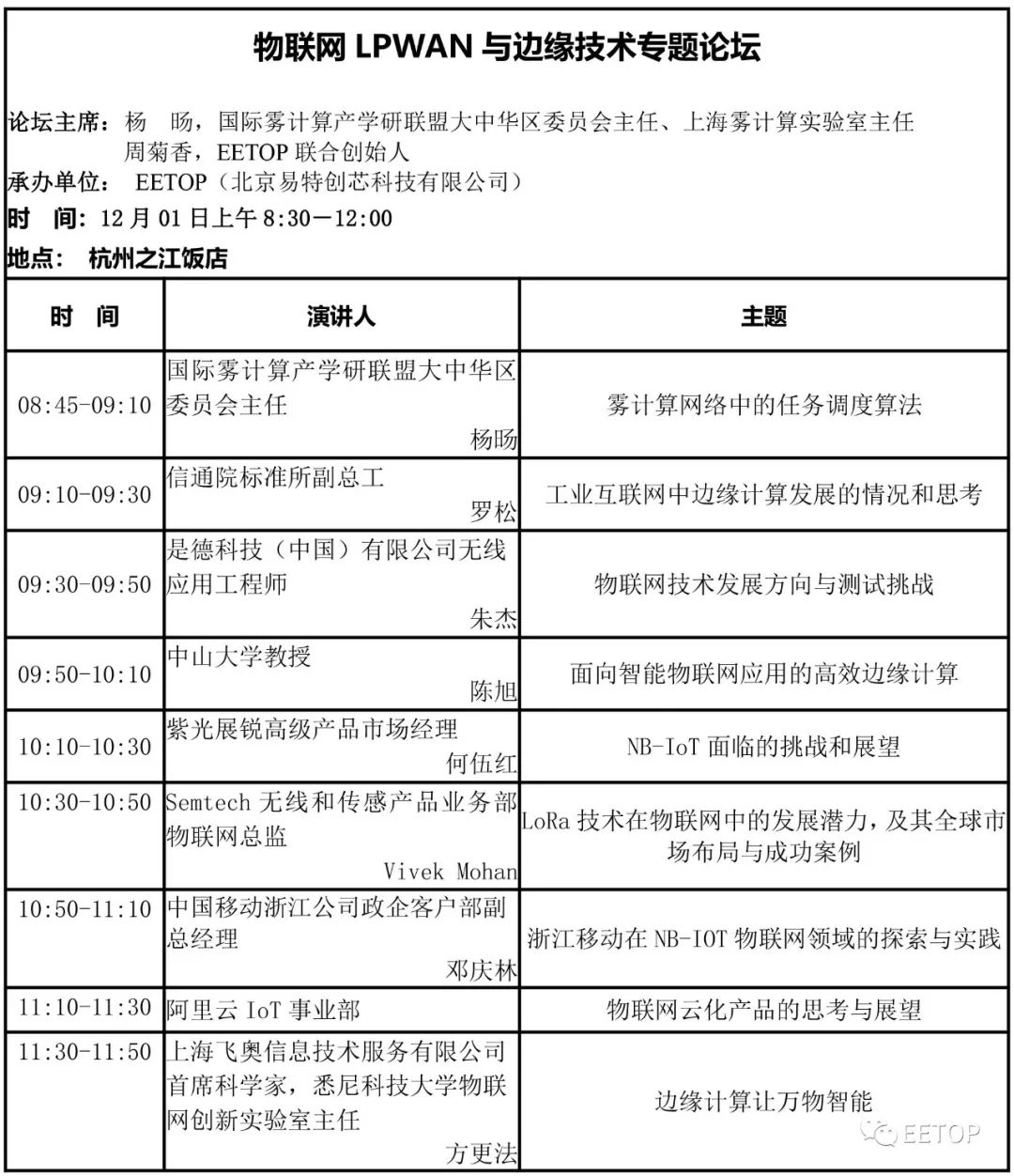
Click to read the original text for conference details and invitations.